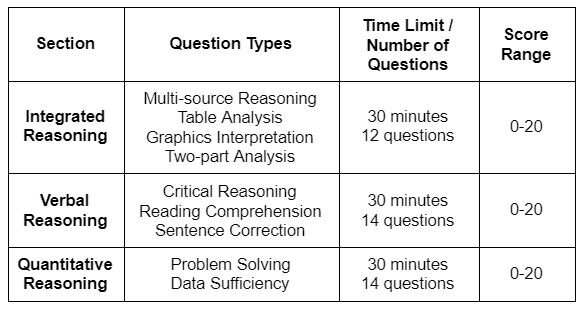What Kinds of Questions are on the Executive Assessment?
The EA features the exact same question types as the GMAT, except it does not have a writing assessment.
Here’s a breakdown of those question types:
Integrated Reasoning Question Types on the Executive Assessment
On the Integrated Reasoning (IR) section, you’ll use a combination of quant and verbal skills to answer complex questions. You’ll see a wide variety of graphs, charts, verbal passages, and other weird combinations of these things. Based on this information, you’ll have to answer a broad range of questions.
Quantitative Reasoning Question Types on the Executive Assessment
On quant, you’ll encounter two question types: Problem Solving and Data Sufficiency.
Problem Solving questions are just standard, multiple-choice questions that you’ve almost certainly seen on other tests. Data Sufficiency questions, on the other hand, require students to evaluate whether two statements are sufficient to answer a question, either individually or together.
Verbal Reasoning Question Types on the Executive Assessment
On the EA Verbal section, you’ll encounter three question types: Reading Comprehension, Critical Reasoning, and Sentence Correction.
Reading Comprehension and Critical Reasoning questions will require you to read a passage and then answer questions about that passage. Sentence Correction questions test your grammar skills and your ability to detangle the logic and meaning of a given sentence.
Wait a minute… if the EA has the same questions as the GMAT, why does GMAC say the EA “requires minimum preparation”?
Yeah, we’re not quite sure what GMAC was thinking when they made this claim. We’ve gone through every question in the EA Official Prep materials, and it’s clear that all of the official EA practice questions are recycled GMAT questions.
Sure, the bar for achieving a competitive score might be lower on the EA than on the GMAT, just because EA scores are used differently by MBA programs (for more on what constitutes a “good” EA result, check out our article on Executive Assessment scores).
But to master the material for the EA, you’d need to study essentially the same content and techniques as you would for the GMAT. So it seems like a stretch to say that the EA fundamentally requires “minimum preparation” in general.
How is the Executive Assessment structured?
The EA sections always follow the same order:
Integrated Reasoning (12 questions, 30 minutes)
Verbal Reasoning (14 questions, 30 minutes)
Quantitative Reasoning (14 questions, 30 minutes)
Overall, the test will take 90 minutes.
Like the GMAT, the EA is an adaptive test -- which means that if you do well early in each section, you’ll see harder questions at the end of each section.
The test adapts up or down in the middle of each section. You’ll start with a six-question mini-test in the IR section, with medium-level questions on average. Within this mini-test, you can go back to review your work and change your answers.
Then, after you submit those six questions, you’ll be presented with a new mini-test of six more IR questions. The difficulty of this second mini-test depends on how well you did on the first mini-test -- if you aced the first six questions, the test will “adapt up” and give you harder questions in the next mini-test. If you bombed the first six questions, the test will “adapt down” and you’ll see easier questions.
The same process is repeated on the verbal and quant sections (except that each mini-test will consist of 7 questions). Your performance on the IR section will not impact your starting point on the verbal and quant sections -- you’ll have a clean slate for each new section.
You can spend as much or as little time on each “mini-test” as you’d. You have 30 minutes total within each section (IR, verbal, and quant), but you can split up those 30 minutes however you choose.
After you complete all three sections of the test, you will see your individual IR, quant, and verbal scores out of 20, as well as your overall EA score out of 200.


